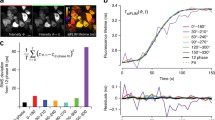You have full access to this open access chapter, Download chapter PDF
Similar content being viewed by others
Correction to: Chapter 17 in: Y. Tang, B. Z. Tang (eds.), Principles and Applications of Aggregation-Induced Emission, https://doi.org/10.1007/978-3-319-99037-8_17
The images in this chapter was taken from external sources and the publishers were not acknowledged and that the correction has been carried out. Below is the list of images with their appropriate captions along with the publishers from whom the copyright permissions were obtained.
Fig. 17.1 Schematic illustration of the light spots for confocal microscopy and STED microscopy. Reproduced from ref [2] with permission from John Wiley and Sons
Fig. 17.3 STED imaging of Hela cells labeled with TTF@SiO2 NPs. Confocal microscopy (a) and STED (b) images of the cells. (c) Fluorescence intensity profiles along the dashed lines across the NP in panel. (Scale bar: 3 μm) Reproduced from ref [2] with permission from John Wiley and Sons
Fig. 17.4 STED imaging of the microtubules labeled with the Red-AIE–OXE nanodots. (a) Confocal and (b) STED images of the microtubules. (c, d) are magnified views of the box region marked in (a, b). (e, f) show the fluorescence intensity profiles of the position indicated by the arrow heads (i) in (a, b) and (ii) in (c, d), respectively. (Scale bar: 1 μm) Reproduced from ref [3] with permission from John Wiley and Sons
Fig. 17.7 (a) Photocyclodehydrogenation process of o-TPE-ON+. (b) Photon counts, (c) fluorescence-on time, and (d) localized precision of o-TPE-ON+ under single-molecule state. (e, f ) Fluorescence imaging of mitochondria in a fixed HeLa cell: (e) Diffraction-limited TIRF image with totally blurred structure. (f) Super-resolution image. (Scale bar: 2 μm) (g) Fluorescence intensity profiles of the single mitochondrion along the yellow dotted line marked in the images. Reproduced from ref [7] with permission from John Wiley and Sons
Fig. 17.8 MitoRed AIE (TPE-Ph-In) is used for dSTORM imaging. (a) Structure of MitoRed AIE; MitoRed AIE shows a high selectivity to mitochondria. Adapted from ref [9]. Reproduced by permission of The Royal Society of Chemistry. (b) Average on-time and (c) average photon counts of MitoRed AIE under single-molecule state. (d) Single-molecule blinking statistics of MitoRed AIE dye are similar or superior to MitoTracker Deep Red (MTDR). (e) 3D live cell super-resolution imaging of mitochondria with MitoRed AIE probe over 8 min. Adapted from ref [8]. Copyright 2016 Nature publishing group
Fig. 17.9 (a) The structure of TPE-Cy and its transformation to the base form, TPE-Cy-OH. (b) Fluorescence decay traces recorded for TPE-Cy-OH in ethylene glycol and glycerol mixtures with different glycerol fraction (f Gly). (c) Fluorescence image (left) and the corresponding surface intensity plot of TPE-Cy stained HeLa cells. Scale bar: 35 mm, λ ex = 330–380 nm. (d) Comparison of fluorescence signals from cell autofluorescence and cells stained with TPE-Cy upon two-photon excitation. (e) FLIM images and (f) fluorescence lifetime distribution histogram of HeLa cells stained with TPE-Cy. Scale bar: 30 mm. Two-photon excitation wavelength: 600 nm. Reproduced from ref [12] with permission from John Wiley and Sons
Fig. 17.10 (a) Design principle of using an amine-reactive dye, TPE-Py-NCS, to label proteins and monitor the micro-environment change in cells through FLIM and FAIM. (b) FAIM images and (c) FLIM images of fixed Neuro 2A cells treated with sorbitol at different concentrations for 30 min and the corresponding fluorescence anisotropy distribution histograms or fluorescence lifetime distribution histograms, respectively. Adapted from ref [13] with permission from The Royal Society of Chemistry
Author information
Authors and Affiliations
Corresponding author
Editor information
Editors and Affiliations
Rights and permissions
Copyright information
© 2019 Springer Nature Switzerland AG
About this chapter
Cite this chapter
Zhao, E., Chen, S. (2019). Correction to: Applications of AIEgens in Super-Resolution Imaging, Fluorescence Lifetime Imaging, and Fluorescence Anisotropy Imaging. In: Tang, Y., Tang, B. (eds) Principles and Applications of Aggregation-Induced Emission. Springer, Cham. https://doi.org/10.1007/978-3-319-99037-8_21
Download citation
DOI: https://doi.org/10.1007/978-3-319-99037-8_21
Published:
Publisher Name: Springer, Cham
Print ISBN: 978-3-319-99036-1
Online ISBN: 978-3-319-99037-8
eBook Packages: Chemistry and Materials ScienceChemistry and Material Science (R0)




